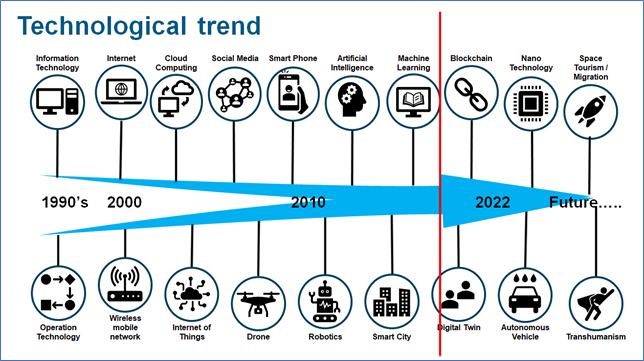Aldous Huxley said in his book: The Brave New World in 1932 that ‘I wanted to change the world. But I have found that the only thing one can be sure of changing is oneself.’ So, how do Business Analysts need to change in this Brave New World? asks BCS Fellow and Principal Business Analyst, Dr. Kitty Hung PhD CITP FBCS.

Information Technology (IT) in the 90s was very much about transforming paper-based records to electronic records on a desktop. Nowadays, we see the emerging technologies such as 5G, 6G, cloud, self-autonomous vehicles, drones, internet of things (IoT), digital twins, blockchain, quantum computing, robotics, artificial intelligence, machine learning are growing exponentially.
These emerging technologies usually intermix with both information technology (IT) and operation technology (OT) and many of the IoT devices are not limited to a computer. IoT devices come in different forms and shapes. One of the challenges faced by Business Analysts is that the IoT doesn’t have the traditional user interface displayed on a computer screen showing the functionality of the systems.
This has made it harder to visualise how the requirements turned to solutions as the functionality is hidden behind the devices. Understanding of the emerging technologies such as what they are, how they are used, who uses them etc. is the key when it comes to gathering business requirements.
Business Analysts need to have the acumen to support the emerging technologies and must be equipped themselves with such knowledge to deal with the increasing complexity and the higher frequency of changing requirements as both have posed a challenge for the Business Analysts to meet the programme and project management’s expectations.
UML, BPMN, SysML
Given today’s rapid and continuous business and technological change environment, the traditional business analysis skill set such as the Unified Modelling Language (UML) and Business Process Modelling & Notation (BPMN) may not be sufficient to model the complexity of the emerging technologies such as IoT devices fitted with intelligence sensors and actuators. Therefore, the ‘modern’ Business Analysts also need to acquire, if they haven’t done so, the System Modelling Language (SysML) which is an extension of UML, provides more powerful diagrams to model complex systems.
Integration
It is not financially viable to throw away all the existing systems and to replace them with new technologies therefore, organisations tend to add new technologies to the existing technology portfolio.
The mixture of existing and emerging technologies has posed compatibility and interoperability issues. Business Analysts must know how to capture the requirements around integration between the existing and new systems including functional, infrastructure and data integration.
Regulations
For you
Be part of something bigger, join BCS, The Chartered Institute for IT.
Emerging technologies such as robotics (e.g: if a robot has killed a human, who is going to be prosecuted?) or autonomous vehicles (e.g: if a self-drive car has committed traffic offences such as going through a red light or speeding, who is going to pay the penalty?) come with new regulations.
New regulations or changes with older ones occur all the time, and they often have an impact on business analysis and requirements. In highly regulated industries, business impact analysis in particular, is an ongoing effort, and Business Analysts must understand the regulations and ethics as to minimise any missteps.
Cyber security
Cyber security issues often accompany new and emerging technologies – while they are still immature they could leave back doors open to intruders looking to hack into the systems. Very often, individuals working on strategic initiatives or new technologies are reluctant to share information, and for good reason.
Cyber espionage – the stealing of trade secrets and proprietary information – has grown significantly in recent years. When Business Analysts capture requirements related to new innovative emerging technologies, there is plenty of sensitive information that needs to be protected. That often gets in the way of business and requirement analysis – and the design of new processes and systems.
UAT without a user interface
User Acceptance Testing (UAT) for applications without a user interface such as IoT devices is to be conducted through the testing of the behaviours and responses of the device to test whether the functionality of the devices will work. When it comes to emerging technologies which are immature and have not been trialled and tested as much as their predecessors, more testing needs to be done to check for errors and bugs to ensure the solutions have met the business requirements.
With the increase in the frequency, thoroughness and depth of testing, Business Analysts should get actively involved in some of the testing activities and must be available for clarifying requirements, should the testers require. Requirement Traceability Matrix (RTM) jointly created by the Business Analysts and testers is an essential tool that helps to ensure that the purpose, requirements and results of the project remain in line with what the customers have initially approved and signed-off.
About the author
Dr Kitty Hung PhD CITP FBCS is a Principal Consultant in Business Analysis of Atkins.

















